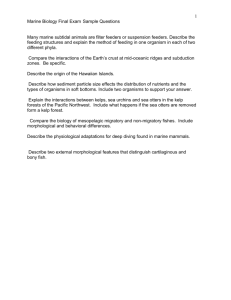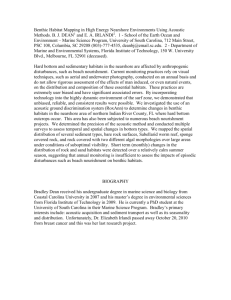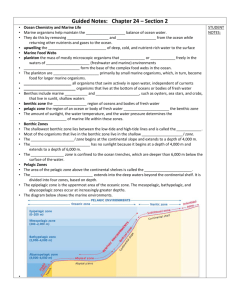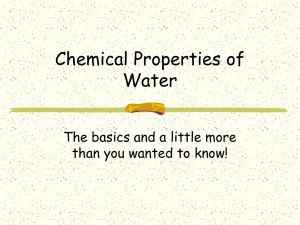Introduction to Marine Ecology
advertisement
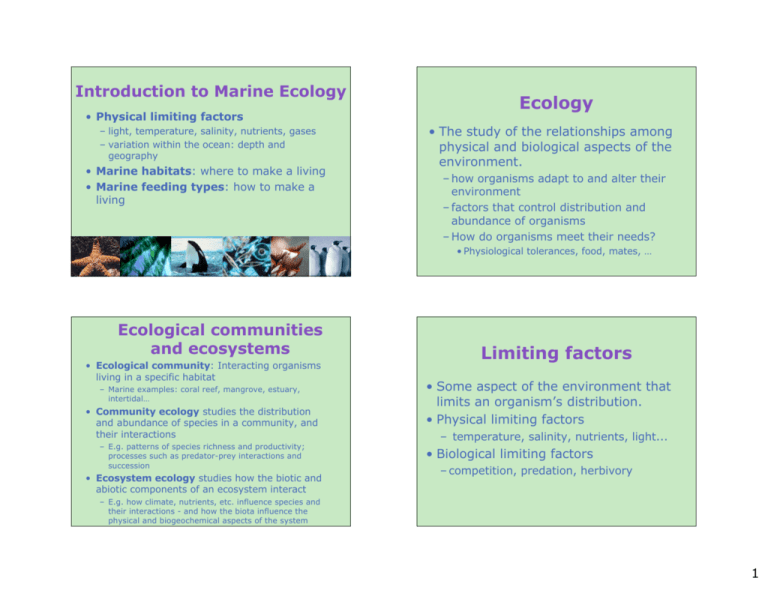
Introduction to Marine Ecology • Physical limiting factors – light, temperature, salinity, nutrients, gases – variation within the ocean: depth and geography • Marine habitats: where to make a living • Marine feeding types: how to make a living Ecology • The study of the relationships among physical and biological aspects of the environment. – how organisms adapt to and alter their environment – factors that control distribution and abundance of organisms – How do organisms meet their needs? • Physiological tolerances, food, mates, … Ecological communities and ecosystems • Ecological community: Interacting organisms living in a specific habitat – Marine examples: coral reef, mangrove, estuary, intertidal… • Community ecology studies the distribution and abundance of species in a community, and their interactions – E.g. patterns of species richness and productivity; processes such as predator-prey interactions and succession • Ecosystem ecology studies how the biotic and abiotic components of an ecosystem interact Limiting factors • Some aspect of the environment that limits an organism’s distribution. • Physical limiting factors – temperature, salinity, nutrients, light... • Biological limiting factors – competition, predation, herbivory – E.g. how climate, nutrients, etc. influence species and their interactions - and how the biota influence the physical and biogeochemical aspects of the system 1 Limiting factors Physical factors: light penetration Coastal ocean Light penetrates deeper in clear, open ocean than it does in turbid, coastal water Open ocean Physical factors: light and light penetration • Photic zone: depth to which light penetrates Photosynthesis 6 CO2 + 6 H2O sunlight glucose – Defines zone of photosynthesis and primary productivity (base of the food web). • Aphotic zone is below photic zone. Most of the ocean is dark. • Dysphotic zone is very low light; too little for photosynthesis C6H12O6 + 6 02 Respiration C6H12O6 + 6O2 6 CO2 + 6 H2O + Energy 2 Light limitation Example: Whale-fall communities -2891 m deep -Monterey Canyon • Confines most productivity to upper 100-200 m • Organisms below this have to be creative in how they obtain food – Feed on detritus – Chemosynthesis at black smokers -Worms and sea cucumbers • New species of worm that feeds exclusively on whale carcasses • Roots that extend into bone • Massive egg sacs, and dozens of microscopic males (larval, with “copious” sperm) living in the female • Why?? http://w w w .mbari.org/new s/new s_releases/2004/w halefall.html Limiting factors: temperature • Temperature affects metabolic rate: the rate at which reactions proceed in an organism • Metabolic rate doubles for every 10°C increase in body temperature • Most marine organisms are ectothermic Limiting factors: temperature Endotherms can tolerate a broader range of external temperature than ectotherms. But endotherms require more energy (food) than ectotherms. – same body temperature as the surrounding water. – clams, shrimp, most fish... • Some marine organisms are endothermic – constant and usually higher body temperature than the surrounding water. – marine mammals, birds, some tuna and sharks. 3 Temperature affects activity • Barnacle cirri beat faster at higher temperature • Faster beat = more efficient feeding Limiting factors: salinity • Normal marine salinity is 35‰ • Too high or too low is damaging – Low diversity in estuaries (low salinity) – Low diversity in areas of high evaporation (high salinity) • Maintaining salt balance is critical organisms do this by: Temperatures in the ocean Extremophiles beyond this range - submarine hot springs - in polar ice: antifreeze glycoproteins in blood Diffusion • Passive equalizing of concentrations • Substance (or temperature) diffuses from high to low concentration, equalizing them • Examples: diffusion of gases into ocean, into cells; diffusion of nutrients into (and wastes out of) phytoplankton – Diffusion – passive movement from areas of high concentration to low concentration – Osmosis – diffusion of water through a membrane – Active transport – active removal of substances from an area of low concentration to high concentration 4 Limiting factor Pressure Osmosis Type of diffusion that equalizes water concentration • High pressure in deep: makes life impossible? • No! Most organisms do not perceive this Water (but not salts) flows thru cell membranes into region of higher salt concentration – No gases in body (gases are compressible) Can create osmotic stress if cell is moved into region of contrasting salinity • Fishes with gas bladders are adjusted for this pressure – Die (explode) if brought rapidly to surface – Can adjust to move up and down gradually on their own Salt water is dehydrating; it removes water from within the cell. Limiting factors: dissolved nutrients • Required for the production of organic matter • Required for photosynthesis - the base of the food web NO3- – Phosphates PO4- surface Low in the photic zone, High in upwelling areas • Limiting nutrients: – Nitrates Global nitrates 200 m Slides/ global nitrate “fertilizers” 1,000 m – Sometimes, Fe (iron), Si (silicon) 5 Global phosphates Fig/ nutrient/energy cycling surface Low in the photic zone, High in upwelling areas 200 m Slides/ global phospho rus 1,000 m Ocean has a tremendous variety of physical habitats! Fig/ typical ocean profiles 6 Marine habitats: Where to make a living • Pelagic zone: living in the water – neritic zone: nearshore, over the continental shelf – oceanic zone: beyond the continental shelf • Benthic zone: living on the bottom – littoral - between high and low tide “intertidal” – sublittoral - out to edge of continental shelf – bathyal - continental slope – abyssal - abyssal plain – hadal - deep sea trenches Plankton Marine lifestyles • Planktonic: drift almost passively; cannot counteract a current. – phytoplankton (plants) – zooplankton (animals) • Nektonic: active swimmers: – fish – reptiles – mammals – birds • Need ways to stay in photic zone – Small mass = slow settling – High friction = more drag • Benthic: Live on the bottom – Epifaunal – Infaunal • An organism can change modes through its lifetime, e.g. larvae or juvenile vs adult 7 Benthic Habitats infaunal, epifaunal Infauna Animals that burrow into soft substrates (sand and mud) • Challenges include: – Displacing sediment (digging/burrowing) – Constructing structurally sound burrows – Protecting tissues from abrasion • Benefits include: – Protection from predators, wave energy, desiccation What’s the best way to swim? • Minimize drag • Be fast – Accelerate – Cruising • Be maneuverable How to swim fast? • Speed of a fish is dependent upon: – body length (long = fast) – beat frequency (more beats/sec = faster) – the aspect ratio of the caudal fin (high = fast) • Aspect ratio is the ratio of the square of the caudal fin height to caudal fin area: AR = (Caudal Fin Height)2/Caudal Fin Area Faster Slower 8 Marine habitats: how to make a living Note “specialists” vs “generalists” • Primary producers: Autotrophs (make own food) Phytoplankton - floating photosynthetic algae Marine habitats: how to make a living • Primary producers: autotrophs Benthic macroalgae Sea grass Marine habitats: how to make a living • Primary producers: autotrophs • Suspension (filter) feeders: filter water for food: – pelagic suspension feeders: zooplankton – benthic suspension feeders:many mollusks, sponges, baleen whales 9 Whale shark (http://en.w ikipedia.org/w iki/Image: W hale_shark_Georgia_aquarium.jpg Jellyfish Yellow tube sponge http://cas.bellarmine.edu/tietjen /images/phylum_porifera.htm Slide/ sponge - colonial Copepod Marine habitats: how to make a living • Primary producers: autotrophs • Suspension feeders: filter water for food • Benthic grazers: scrape the bottom for algae: sea urchins, snails, nudibranchs, manatees 10 Marine habitats: how to make a living Sea urchin Nudibranch Gastropod (snail) • Primary producers: autotrophs • Suspension feeders: filter water for food • Benthic grazers: scrape the bottom for algae • Benthic deposit feeders: eat sediment: many worms, crabs, some sea urchins, some fish Manatee Heart urchin Marine habitats: how to make a living • Primary producers: autotrophs • Suspension feeders: filter water for food • Benthic grazers: scrape the bottom for algae • Benthic deposit feeders: eat sediment • Predators: eat other animals: sharks, many fish, dolphins, octopus, killer whales, barnacles, corals Primary, secondary, tertiary.... 11 Shark Coral polyps Barnacle Frogfish (camouflaged) Orca http://w w w .s hiftingbaselines.org/ blog/archives/2005_11.html Tuna http://e n.wik ipe dia.o rg/wik i/Im a ge :Mo nta stre a _ca ve rno sa .jpg Octopus 12


